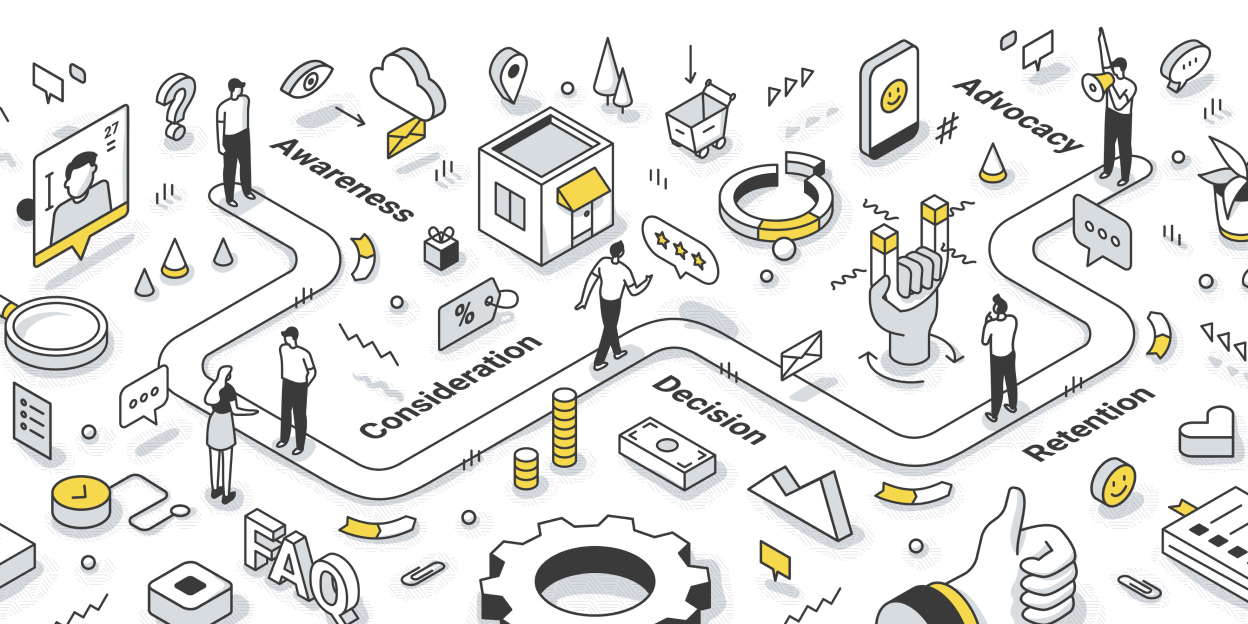What is customer journey mapping?
Customer journeys can be complicated and are rarely linear, crossing multiple devices and channels. By conducting a customer journey review, aggregating and analysing your customers' journeys, you can better understand their pain points, behaviours, needs and expectations. The best way to plot out and analyse the data you collect from your audience is to carry out customer journey mapping.
A customer journey map brings their journeys to life visually, making it easier to see how their experiences flow across your brand's touchpoints - all the places where your customers can interact with you, both online and offline. It's a strategic approach to improving your customer experience and can be more effective than trying to understand and improve individual touchpoints at a tactical level.
What are the benefits of customer journey mapping?
It can improve your overview of the strengths and weaknesses in your current customer journey. By reviewing the journey your customers take when interacting and purchasing from you, as well as their needs, thoughts and feelings along the way, you'll better understand what your customers want from you at each stage and whether you're meeting those needs.
When and why is a customer journey map used?
Here are some popular examples of when and why you might want to use a customer journey map.
To help better understand your customers
Conducting a customer journey analysis to create a customer journey map can be an excellent way to help your business better understand how customers engage with your brand. It can help colleagues across the business see how each touchpoint contributes to the customer journey.
To identify gaps in the customer experience
Dedicating time to a customer journey mapping project and visualising your customers' journeys can help you review and understand them and their experiences. Customer journey mapping can shed light on pain points or experience gaps you might need to know about.
To improve your products and processes
By plotting out the various touchpoints in a customer's journey with your brand, you can highlight problematic or inefficient processes that might lead to drop-offs or complaints. It can also help you to refine and enhance your products and services.
To deliver relevant and effective communications
Creating a customer journey map can help you to recognise your audience’s wants, needs, questions, and expectations. Use this information to create an insight-led marketing and communications plan. Delivering targeted and relevant messages at critical stages throughout the customer journey can help them feel appreciated as consumers.
To prevent churn
Every business has a churn rate – the rate at which customers stop doing business with your brand. A user journey analysis can offer insight into where and why your customers might encounter problems or frustrations. By compiling your customers' experiences, you can identify areas of concern and plan to improve them.
To close the deal
Mapping out the customer journey will provide a clear indication of the touchpoints and experiences that lead up to the point of conversion. By matching your prospects' needs to how they're fulfilled in the moments before conversion, it becomes easier to exceed their expectations and deliver experiences that convert to sales.
A customer purchase journey is the path a consumer takes, from identifying a problem or need to purchasing from a brand and becoming a loyal customer. There are different versions of the customer purchase journey, which you can visualise as a funnel, but we've identified the five stages as:
- Problem or need
- Search
- Consideration
- Purchase
- Brand loyalty
Our survey of 2,000 UK shoppers found that businesses must listen, learn, and engage consumers at every customer journey stage - your customer journey analysis will ensure you're able to meet their needs more effectively.
How to create a customer journey map
Follow our four-step guide to learn how to create a customer journey map.
1. List your customer touchpoints
Start by creating a list of every touchpoint for your business. Consider where each touchpoint sits in the customer journey – from brand awareness to loyalty – and organise them accordingly. Think about how your audience might feel at each touchpoint and consider each potential obstacle.
2. Identify your customer personas
Use business data, market research, and your target audience characteristics to segment your customers into important groups and create customer personas. Select a persona to be the focus of your customer journey map. Each persona will have a different journey, so try not to tackle too many personas with just one map. Choose your most common persona (i.e. the one that represents most of your customers) and start from there.
3. Gather research
It's essential to make the most of the insights, feedback, and data you have about your customers. The more data-driven your customer journey analysis and resulting map is, the more valuable it will be in meeting your journey mapping goals. Use several data sources to gather information for your customer journey map, including:
- Customer satisfaction surveys – Use existing responses or create new surveys to get targeted insights into your customers' experiences. Look for the most mentioned touchpoints or themes across multiple touchpoints.
- Customer reviews – Customers usually leave reviews if they are happy or frustrated. Analyse your reviews to see where these moments take place.
- Customer experience metrics – If you already use Net Promoter Score, Customer Effort Score, or another method of collecting customer feedback, analyse the data you receive to look for themes or popular topics.
- Surveys – Reaching out to existing customers can be helpful in gathering research for your journey mapping project. On-page surveys can collect insights to understand their website experience better.
- Website analytics – Analyse how touchpoints are contributing to your website traffic, which ones drive sales, where the most drop-offs occur, and which pages are causing frustration.
- Website searches – If your website has search functionality, review the results to see which topics or questions your customers seek.
- Competitor research – Research your competitors and their touchpoints to identify areas where they outperform you and could potentially acquire new customers.
- Conducted interviews – Sitting down with a panel of your customers or target audience can be invaluable. Ask questions to understand their expectations of your brand and how they found the customer journey.
- Site navigation maps – Analyse your website navigation, looking at how people move from page to page to complete their goals. It should provide a logical and straightforward experience that turns website visitors into customers.
- Chatbots and FAQs – Use analytics to see which FAQ pages get the highest engagement and better understand where your customers struggle with their experience with your brand. Chatbot queries also provide valuable insight into common support topics.
- Insights from sales – Conduct research with your sales team to find out the most common customer and prospect questions, frustrations, expectations and needs.
4. Identify elements to include in your customer journey map
Your customer journey map can represent different stages in the customer journey. Start by analysing the current state of your customer journey touchpoints to highlight how your prospects and customers interact with your business in real-time. The key journey mapping elements are:
Current state: Current state journey maps offer insights into how things are currently working and flag any issues or areas for improvement. By starting with the current state, you'll create a benchmark map to improve on, helping you track any wins from your improvements.
Day in the life: Day-in-the-life customer journey mapping plots the typical day of your focus persona. This type of map shows you when your customers interact with your brand when they might engage with your products or services, and which problems they might face as the day progresses.
Future state: If you know the current state of your customer journeys, it's much easier to plan ahead and identify how to deliver new customer experiences. Future state journey maps are driven by your brand's vision for customer experience, focusing on creativity, ideal scenarios, and ideation.
Service map: Service maps focus on what happens behind the scenes regarding delivery and operations. They combine the scenarios the customer faces with scenarios affecting your organisation and are most effective when created by colleagues from different areas of your business.
Customer journey analysis
Whether you use Google Analytics on your website, Facebook Analytics for social media, or track your customer data using another platform, it's important to regularly conduct a customer journey analysis. If you have multiple sources of website and marketing tracking, you should be able to collate the data to identify the following:
- Your customer demographics, including age, gender and interests
- Common customer website journeys
- The best-performing sources of traffic and referrals to your website
- Customer contact volumes
To find out what customers say about your brand, look at your customer reviews and use social listening tools to track conversations involving your brand name. You can also set up short surveys, email follow-ups, or interviews to better understand the journey your customers take with you.
Customer journey mapping tools
Customer journey mapping tools can help you maximise every customer touchpoint that a prospective shopper has with your brand before buying, helping to improve your conversion volumes and, ultimately, your bottom line. Here are seven customer journey mapping tools to get you started:
1. Smaply
One of the top mapping tools is Smaply. It offers three tools – journey mapping, persona mapping, and stakeholder mapping – helping you get to grips with the entire customer journey.
2. Lucidchart
Lucidchart is a purpose-built customer mapping tool that 99% of Fortune 500 companies use. It offers a range of integrations, helping you to import data automatically from your website, social media channels, and analytics.
3. Canvanizer
If you're looking for a simple, straightforward and free-to-use tool, Canvanizer is a good choice. Choose from various templates to help with customer feedback, SWOT analyses, and social media strategy planning.
4. OmniGraffle
Although not purpose-built for journey mapping, OmniGraffle helps you create diagrams that easily explain complicated ideas. You'll need to manually add information from your data sources, but the tool will simplify your customer journey mapping process.
5. PowerPoint
Customer journey maps are usually presented as flow charts or diagrams, which you can easily create using PowerPoint. The template below is a good example of how simple your customer journey map can be.

Credit: slidesgo.com
6. Google Analytics
If you're new to customer journey mapping, Google Analytics has information to get you started. For example, it can show you your customer behaviour flow, which explores how people make the most common journeys on your website.
7. UXPressia
Finally, UXPressia is another purpose-built software solution that uses customer personas and journey maps in tandem to create a storyboard with commentary, quotes, problems, and customer experiences at each point in their journey.
Collecting customer feedback is a key part of your customer journey analysis process. To find out more about how you can use your customers' opinions to understand them – and your business – better, get in touch with a member of our team.



